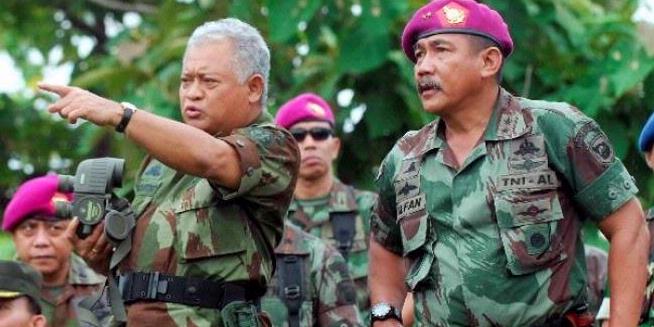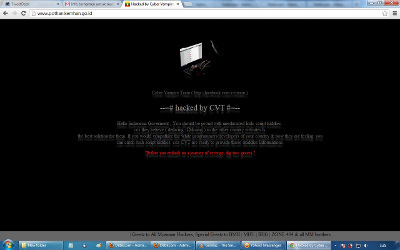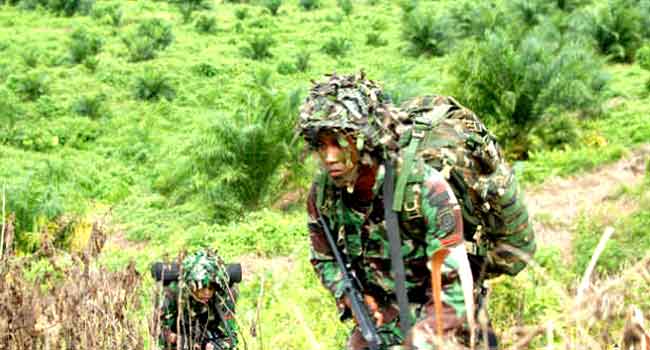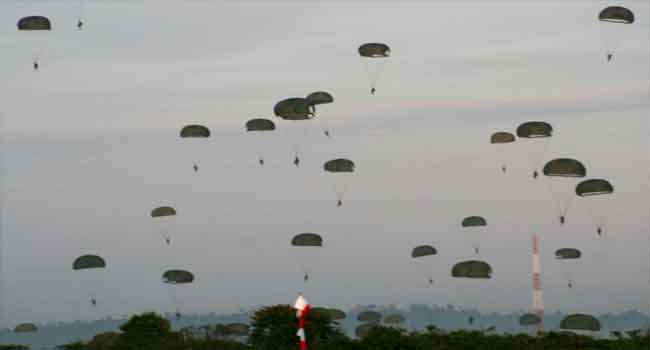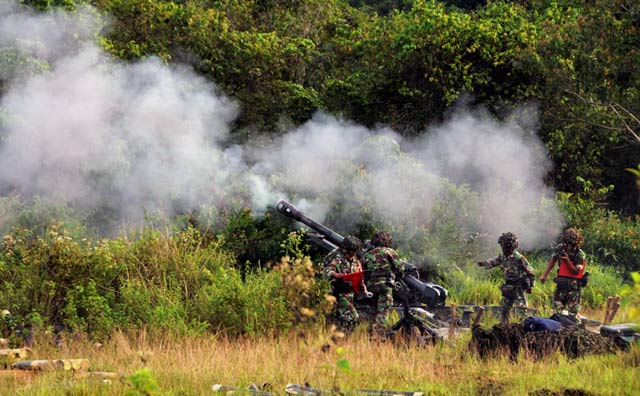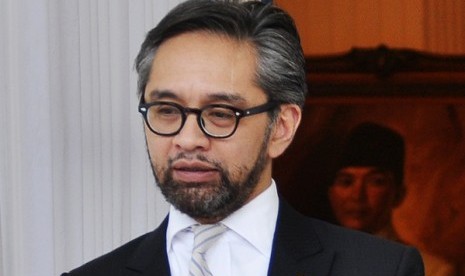By
Benedict R Anderson
Generally speaking, the collapse of the currency
helped to create a pervasive atmosphere of fear, uncertainty and anger.
These tendencies help to explain why the largest and worst massacres
took place in the country's villages, where land was most seriously
contested and the big-party mass organizations were most active.
 |
| Great Mosque, Medan (Credit: Andre Vltchek) |
The fatal weakness of the PKI emerged from its decision to take the
parliamentary road. It was not an irrational decision, given the vast
extent of the archipelagic country and its huge ethno-religious
diversity, as well as the party's commitment to "national integrity",
and the menacing proximity of America's armadas and air power. But it
meant that the party was mostly above ground, its members well known nationally and locally, and it had no armed power of its own at all.
The PKI attempted to substitute for this weakness an increasingly harsh
rhetoric, which did not add to its real power and frightened its
every-day enemies. Meantime, the anti- communist army leadership
increasingly backed, openly and surreptitiously, rightwing social,
political, religious, and intellectual organizations. Communism was
banned within its own ranks.
Origins of the slaughter
Army leaders, helped by advice and half-concealed support from both the
Pentagon and the CIA - then reeling under heavy reverses in Vietnam -
had long been looking for a justification for a mass destruction of the
party. Now the September 30th Movement and the murder of the six
generals provided the opening they awaited.
Almost immediately, the army-controlled media started a lurid and
successful campaign to convince the citizens that the Movement was
simply a tool, manipulated behind the scenes by the party. By no means
was it an internal military mutiny. The communists were said to have
been planning a vast extension of the murders to the civilian population
all over the country.
The army's campaign began on October 3, when the bodies of three of the
generals were exhumed from a dry well in a remote part of the Air
Force's Jakarta base. (They had not been killed at home, but kidnapped
to this area and then shot dead). The media, using blurred and retouched
photos of the bodies, claimed that the victims had had their eyes
gouged out and their genitals sliced off by sex-crazed communist women.
(Many years later, thanks to military carelessness, the post-mortems
written up on October 3 by experienced forensic doctors, and directed
personally to Suharto that same day, came to light. No missing eyeballs
or genitals, just the lethal wounds caused by military guns.)
In a move that would have pleased Goebbels, the Movement's full name was
deleted in favor of Gestapu (GErakan September TigA PUluh). No one
noticed that the word order here is impossible in the Indonesian
language, but is syntactically perfect in English. Very few Indonesian
generals then had perfect English). On top of the hyperinflation, this
cunning Big Lie propaganda had the desired effect: massive
anti-communist hysteria.
The coolly considered plan of Suharto and his henchmen for the physical
and organizational destruction of the party was based on the huge
numbers of its members, affiliates, and supporters. To accomplish this
mission as rapidly as possible, army personnel were not enough;
civilians had to be involved on a large scale, with half-concealed
military direction, financing, intelligence, transportation, and even
supply of weapons.
As secretive corporate bodies notionally devoted to external defense
against foreign enemies, armies almost never boast about mass murder
(see the mendacious handling of the Rape of Nanking by the Japanese
military and the near-genocide of Armenians by the Turkish army).
International scandal was to be avoided as much as possible. National
armies are not supposed to slaughter their fellow-citizens, especially,
as in the case of the PKI, if they are unarmed and put up very little
resistance.
Who were the primary collaborators?
The two provinces with the highest number of victims, Muslim East Java
and Hindu "Paradise Island" Bali are exemplary. Both provinces were
densely populated, ethnically quite homogeneous, and with strong,
conservative, traditionalist leaderships. The key thing to bear in mind
when we come to consider North Sumatra is they were longstanding
strongholds of the two well-rooted legal, "national" political parties,
other than the PKI, both with very large organizational and popular
bases. In East Java it was the traditionalist, orthodox Muslim Nahdlatul
Ulama, with its militant youthful-male affiliate Ansor. In Bali, it was
the PNI (National Party) led locally by landowners, Hindu priests, and
members of the two upper castes of Satrias and Brahmins.
Small Catholic and Protestant parties with their affiliates were also
used in places where these religious minorities were influential. (The
large "modernist" Muslim party, Masjumi, fiercely anti-communist, was
organizationally unavailable, since it been banned and disbanded in 1959
for its role in the civil war of 1958-59, of which more later).
These civilians were not professional killers. Once the massacres were
over, they "returned to ordinary life" while the military went on
killing large numbers of people in East Timor, Atjeh and Papua over the
final two decades of the Suharto dictatorship. Many of them, in an
atmosphere of media-generated hysteria, genuinely believed that "they
will kill us if we don't kill them first". Needless to say, the
military had no interest in punishing any of those involved, but their
immunity was also guaranteed in part by the national institutions to
which they were affiliated.
Aftermaths? During his brief presidency (October 1999-July 2001),
Abdurrrahman Wahid, the charismatic, "progressive", and politically
astute Nahdlatul Ulama (NU) leader, decided to ask forgiveness from
surviving ex-communists. He did so, however, not for individual killers,
but for Ansor in particular and the Nahdlatul Ulama in general. (No
other national-level politician has followed his example).
More striking is the fact that over the past decade many young members
of Ansor, born well after 1965, began systematically to help communists
who had managed to survive the massacres and years and years of brutal
imprisonment. Fairly recently, a reconciliation meeting was held in
Jogjakarta between NU and ex-communist women. Everything went well,
until an elderly communist described in detail how she had been raped
and tortured by Ansor members. As she spoke, a young Muslim girl stood
up, ashen-faced, and then fainted. Among the rapists and torturers she
recognized her own father.
It is interesting to note that, quite early on, stories circulated
widely that "amateur" killers had mental breakdowns, went mad, or were
haunted by terrifying dreams and fears of karmic retribution. Otherwise,
silence. Nothing to boast about in public or on TV, one might say.
Medan and North Sumatra: Local history
Joshua's Medan/North Sumatra was and is very different. The strange,
dull name already tells one something. It simply means "field" or "open
space". It was the last major city begotten by Dutch colonialism -
beginning to rise only in the 1870s and 1880s, when the colonial
authorities was realized that the surrounding fertile and near-empty
flatlands were perfect for the development of large-scale agribusiness -
tobacco, rubber, palm-oil, and coffee plantations. One of the earliest
oilfields in the colony was also discovered there just in time for the
automotive revolution.
The area was thinly inhabited by Malays, related to the Malays across
the narrow Straits of Malacca in today's Malaysia. In so far as there
were any rulers at all, these were very small-scale and without much
armed power, even if some called themselves "sultan". For their own
reasons, the Dutch protected these petty rulers and allowed them to
share in the profits of the expanding economy; but the "sultans" had to
do what they were told.
Medan was created in the era when the Dutch colonial regime abandoned
monopolistic mercantilism and adopted British-enforced economic
liberalism and open markets. Hence a motley crowd of investors - Dutch,
British, German, Austrian, American, and eventually Chinese and Japanese
- poured in.
From the start, there was the huge problem of creating a submissive
labor force. The local Malays were too few and anyway not interested,
and the large numbers of young Chinese imported from southeast China and
Malaya-Singapore soon proved too refractory and mobile to be long
usable. The answer came with the recruitment of indentured laborers from
poverty-stricken, overpopulated Java.
It was a kind of modern slavery. Laborers were not only pitilessly
exploited but had to sign contracts preventing them from quitting and
making sure that their "debts" to the companies that transferred them to
Sumatra could rarely be repaid - thanks largely to company stores.
Thus, at least until the onset of the Great Depression, Medan was a bit
like a Gold Rush town.
One can watch the process by comparing the figures in the only two censuses the colonial rulers ever held. 1920:
23,823 natives, 18,247 so-called foreign orientals (Chinese, Arabs,
Indians) 3,128 "Europeans", who included Japanese, for a total of
45,248. 1930: 41,270 natives, 31,021 foreign orientals, and 4,293 "Europeans", for a total of 76, 544.
It was the only significant Indies city in which the native population
had only a tiny 53% majority. (The 1930 total population was a bit
smaller than the capital of today's Solomon Islands; meantime Medan has
grown to over 2 million). From Minangkabau West Sumatra, Atjeh (Aceh),
and Batak Tapanuli came traders, newspaper and magazine publishers,
reporters, ulamas, and Protestant small businessmen, schoolteachers,
preachers and low-level officials. Non-indentured Javanese moved in too,
serving as small and medium merchants, lawyers, newspapermen, teachers,
foremen, accountants, nationalist activists, and civil servants.
The Field was thus far more variegated than any other Indonesian city,
including even the capital Batavia (today's Jakarta): Europeans of
various kinds, Chinese, Americans, Indians, Japanese, Arabs,
Minangkabau, Bataks of many sorts, Atjehnese (Acehnese), Javanese and so
on. None formed a dominant majority. As a consequence, there was
religious variegation too: Protestant British, Dutch, Americans, Germans
and Toba Bataks, Catholic Dutch and Austrians, Confucian and Buddhist
Chinese, Hindu and Muslim Indians, strong Muslims like the Minangkabau
and Atjehnese, and syncretic Hindu-Islamic Javanese.
But of course, there was always a stable racial hierarchy, with Whites
and "honorary-white" Japanese at the top, Chinese, Arabs and Indians in
the middle, and natives mostly at the bottom.
The Field also was notorious for its Wild West social mores - gambling
and prostitution were widespread, and handled by mainly Chinese taukes
and a mixed ethno-racial rag-bag of thugs. (To get a nice picture of
Medan at that time, one can profitably read the final, confessional
chapter of Mangaradja Onggang Parlindungan's weird masterpiece, Tuanku Rao). Opium was a state monopoly.
In early 1942, the Japanese military, having disposed of the British in
Malaya and Singapore, took over the Dutch East Indies in a few weeks.
 |
| Japanese military attack Rabaul, 1942 |
Sumatran and Bornean oil was the military's main interest, but the
plantation economy also fell into its hands. However, effective Allied
bombing of Japanese shipping soon made the export-oriented agribusiness
economy collapse, leaving in place only domestic demand and the
military's local needs. In North Sumatra, the indenture system broke
down to make way for smallholder producers of foodstuffs like rice,
vegetables, tea, and coffee, as well as castor oil. To make this new
wartime economy work, the Japanese authorities opened the door to
"illegal" occupiers of agribusiness lands, including a huge wave of
Protestant Toba Bataks from the interior.
After the American atom-bombing of Hiroshima and Nagasaki, the Japanese
state surrendered unconditionally, but several months passed before the
British and Dutch could bring colonial military power back to the
Indies, and in this vacuum the Republic of Indonesia was born on August
17, 1945.
In the exhilarating, chaotic first year of the revolution (1945-46),
there were a number of regions in Sumatra and Java which experienced
vengeful revolutionary onslaughts on "collaborators" with Japanese and
Dutch, semi-feudal local aristocracies, abusive civil servants, and so
on. The most chaotic and bloodthirsty of these occurred - unsurprisingly
- in North Sumatra. The local petty sultanates were overthrown with
ease; many of the Malay "aristocrats" were murdered and their wealth
stolen or confiscated. Indonesia's greatest poet, Amir Hamzah, was among
the victims.
Toba Bataks, Atjehnese, Simalungun Bataks, and Javanese seized Japanese
or Dutch guns, and fought each other for the spoils without being able
to establish any coherent political order. The Republic's
Socialist-dominated government was appalled by all this, knowing that it
would blacken the country's name overseas, enrage colonial-era
investors wanting their properties back, and alienate possible
diplomatic allies. Gradually, with military help, some kind of order was
established, after which the Dutch succeeded in reoccupying Medan's
plantation belt. But not for long.
In December 1949, after four years of intermittent war and negotiations,
the Netherlands signed over sovereignty of the old colony to a "Federal
Republic of Indonesia", one of whose components was North Sumatra
(then still called East Sumatra), headed by surviving local aristocrats.
But within a year, federalism disappeared, the aristocrats succumbed,
and today's Unitary Republic was established.
The central condition of this transfer of sovereignty, insisted on by
the rapacious Americans, was that all Dutch (and British and American)
pre-war properties be returned to their colonial-era owners. The
situation was particularly volatile in the surroundings of Medan. In the
last two decades of colonial rule, the Field had become a hotbed of
anti-colonial nationalism. This trend accelerated in the last year of
Japanese rule and after the declaration of independence. The radical
language of "revolution" made a deep impression too, mostly for the
good. But revolution also allowed hardened criminal elements to operate
under its aegis, sometimes with half-genuine revolutionary commitment.
 SANGATTA - Subuh, kemarin, Pantai Sekerat, Bengalon,
Kutai Timur, lain dari biasanya. Suara tembakan tank amfibi membelah
suasana pagi buta. Kendaraan baja dari tengah laut ini disertai ribuan
personel. Tak mau kalah, gemuruh pesawat tempur SU-27/30, Dragon Flight
F-16, dan Elang Flight 2 Hawk melintas langit dan menjatuhkan bom di
titik sasaran.
SANGATTA - Subuh, kemarin, Pantai Sekerat, Bengalon,
Kutai Timur, lain dari biasanya. Suara tembakan tank amfibi membelah
suasana pagi buta. Kendaraan baja dari tengah laut ini disertai ribuan
personel. Tak mau kalah, gemuruh pesawat tempur SU-27/30, Dragon Flight
F-16, dan Elang Flight 2 Hawk melintas langit dan menjatuhkan bom di
titik sasaran.
